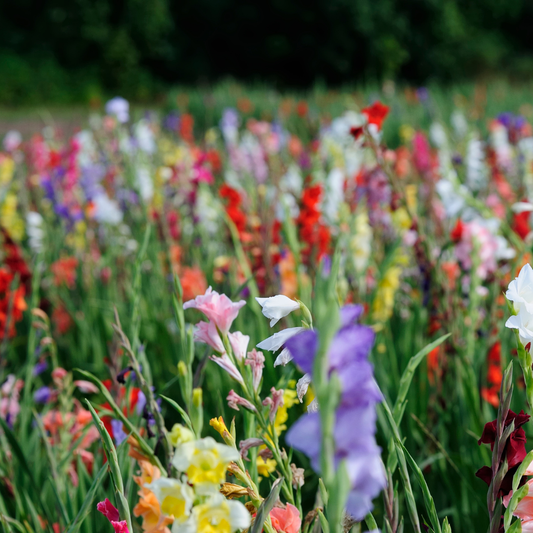
When to plant lily of the valley?
Share
When to plant lily of the valley?
Lily of the Valley, also known as May lilies, may be small in stature, but they're big on fragrance and charm. These adorable white flowers pop up in spring and are real eye-catchers in your garden or in a flowerpot. But when is the right time to plant these flowering gems? And how exactly do you go about it as a beginner?
The ideal period to plant lily of the valley
The best time to plant lily of the valley is in the fall, usually in September or October. This may seem early, but that's because, like many other spring-flowering plants, they need a period of cold to bloom. This cold period stimulates the bulb (or in this case, the rhizome) to emerge from the ground in spring.
If you're planting lily of the valley in the ground, choose a cool, damp day—for example, a typical Belgian autumn day with clouds and light rain. This will help prevent the roots from drying out. In a greenhouse or cold frame, you can plant until early November, as long as there's no night frost and the soil temperature remains above 5°C.
Planting instructions for open ground
Choose a spot in partial to full shade, as lily of the valley doesn't like direct sunlight. In their natural habitat, they often grow under trees or shrubs, where the sun is somewhat filtered. Ensure the soil is fertile and well-draining, for example, by adding some perlite or compost to improve its structure.
Dig small holes about 5 cm deep and plant the rhizomes horizontally, with the tips just below the soil surface. Leave about 10 cm between each plant, as they will spread quickly. Water well after planting to allow them to establish properly.
Planting lily of the valley in a greenhouse? Here's how!
Don't have space in the garden or want to control flowering a little more? Then you can easily plant lily of the valley in a conservatory or veranda. Use well-draining pots and fill them with airy potting soil, for example, enriched with vermiculite , which retains moisture without drowning the roots.
Start this in the fall as well, between mid-September and the end of October. Place the pots in a cool spot in your greenhouse where they won't dry out, but also won't overwinter. Note: lily of the valley doesn't like bone-dry air, so make sure to spray them regularly with a plant sprayer to increase the humidity.
Want to force lily of the valley yourself for indoor flowering?
Want to enjoy the wonderful scent of lily of the valley indoors this spring? You can try "forcing" them. This process simulates winter by giving the rhizomes a cold period of about 10 weeks in the refrigerator (not the freezer!). Then place them on a warm windowsill, and voila – within a few weeks they'll be blooming in your living room.
Use a beautiful pot that complements your interior – feel free to browse our collection of pots for houseplants . This sustainable idea ensures you can enjoy their fragrance even in an apartment without a garden.
Good to know: poisoning and safety
Although lily of the valley may seem irresistible, they are not edible—for humans or animals. All parts of the plant are poisonous. So, if you have pets, it might be better to choose an alternative like the Chinese Money Plant , which is safe for furry housemates and easy to care for.
Combining lily of the valley with other plants?
Yes, please! Because they thrive in shade, lily of the valley makes excellent companions for plants like Asplenium Parvati or Dracaena Marginata – which also prefer not to be in direct sunlight. For a truly forest-like effect, consider Ficus Lyrata for some height and structure.
When planting: what should you keep in mind?
Always check that your soil isn't too wet or heavy, especially if it's clay. If it's too compact, the rhizomes can rot. Consider adding hydroponic clay to the bottom of your pot or planting hole for better drainage.
Avoid using fresh manure or too much fertilizer – this can burn the roots instead of nourishing them. Instead, use modern soil improvers like pumice or humus-rich potting soil specifically formulated for flowering plants.
After planting: when does flowering occur?
If you planted your lily of the valley correctly in autumn, you can look forward to those first gracefully drooping white bells starting in April. The blooming period usually lasts about two weeks, depending on the weather. Cool, slightly damp weather keeps them looking beautiful longer.
After flowering, simply leave the leaves until they turn brown and die back naturally. This allows the plant to store energy for the next flowering season. A bit like the Caladium , which also works with dormancy periods.
Conclusion: plant lily of the valley with love and timing
Whether you plant them in the ground or in a pot in the greenhouse, the secret to lily of the valley lies in the right planting time in autumn. A cool, moist day, without bright sun or frost, is perfect. Give them patience, humus-rich soil, and some shade, and they'll reward you with a fragrant bloom every spring.
Discover our other tips in the series about when to plant flower bulbs , or browse our collection of easy plants for more green discoveries.


